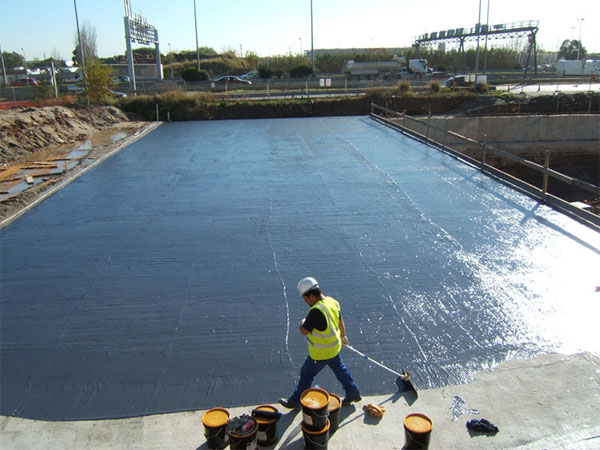Waterproofing of structures is a tricky problem in building construction, mainly because of the surface alignment issues. This can lead to water ingress creating opportunities for leakage. Also, surfaces require sumps or collection pits for the water to flow into before entering the vertical drainage pipes, which is another great source of leaks. Leakage is always typical by nature though it ends up in the permeation of water or any liquid or gas through or between surfaces. A lack of appropriate leakage investigation and monitoring can result in repairs that are unsuccessful in controlling or reducing leakage. Water leakage has become an important issue and needs to be analyzed correctly. It has become important to know the process which suits your project requirement. It is important to look into several provisions that might leakage. Based on that one needs to carefully plan and adopt leak proof waterproofing systems. With the right approach, one can achieve the desired objective during pre/under/post-construction stages.
Specifications for leak-proof waterproofing
- Structural consideration
- Architectural functions
- Concrete durability
- Joints fittings
- Selection of materials
Inadequate waterproofing systems can affect not only the life of the structure but also affect the aesthetics and can pose health hazards to the inhabitants. Critical areas which require waterproofing are-
- Substructure- Basements, Underground Tanks
- Superstructure- Washrooms, Kitchen, Terrace, Podium, Waterbody
- Elevation- Exposed RCC, Glass, Tile/Stone, Exposed brick, Plastered wall
Different types of Leak Proof Waterproofing Systems
Integral waterproofing system
Integral waterproofing admixtures are formulated to affect the properties of the hardened concrete and not those of concrete in its plastic state. Water repellent admixtures, conventional admixtures, and air entrainers may increase the workability of the plastic mixes slightly. Some forms of integral waterproofing will even self-heal minor cracking. Integral waterproofing aims to densify the concrete to prevent water ingress and/or convert wettable capillaries to non-wettable types that would eventually lower the penetration of water into the system. On the other hand, inert pore fillers or reactive pore fillers, due to their finely divided particle sizes may decrease workability slightly. These for example can be used in water storage tanks, wet areas, basements, STPs, Tunnelling Concrete, Underground structures and other similar structures.
Primary waterproofing system
Waterproofing by providing external physical barriers like a pre-formed or liquid applied membrane, joint sealing, grouting etc. Since the technology has grown there is now a wide range of primary waterproofing systems available in the market. A few of the popular ones are discussed below.

Brickbat Coba Waterproofing
Brickbat Coba is a very effective method used for waterproofing. For all existing treatments, a coating on the slab top is removed and the surface cleaned by a hard wire brush and washed with water. The surface should be free from any oil, grease, dust, etc. Remedial measures must be taken to all structural cracks as per standard practice. All non-structural cracks more than 0.5 mm wide and construction joints if any should be cut in a “V” shape, cleaned with a wire brush, and washed, the cracks are then filled by polymer-modified cement or mortar using acrylic polymer, with an additional slurry mix is spread upon the cleaned roof surface.
Polymer modified bitumen waterproofing
Polymer modified bitumen (PMB) is one of the specially designed and engineered bitumen grades that are used in making pavement, roads for heavy-duty traffic, and home roofing solutions to withstand extreme weather conditions. PMB is a normal bitumen with the added polymer, which gives it extra strength, high cohesiveness, and resistance to fatigue, stripping, and deformations, making it a favorable material for infrastructure. This type of waterproofing system withstands temperature fluctuations and high mechanical loads providing long-term, reliable, and effective waterproofing. The polymer-modified bitumen sheet membrane provides additional flow resistance that makes it possible to use the material in a very hot climate.
PVC waterproofing
A PVC waterproofing membrane is made of high quality flexible (plasticized) polyvinyl chloride. Based on the application area there are reinforced and unreinforced membranes. A reinforced waterproofing membrane has a reinforcing base in the form of a polyester mesh or glass fiber and it is used for waterproofing of roofs. Reinforced membranes have increased durability. Unreinforced membranes are more flexible, have high tear resistance, and are used for waterproofing of underground structures, tunnels, swimming pools.
EPDM membrane waterproofing
EPDM is a semi-crystalline material with ethylene-type crystal structures at higher ethylene contents, becoming essentially amorphous at ethylene contents that approach 50 wt%. Rubbers with saturated polymer backbones, such as EPDM, have much better resistance to heat, light and ozone than unsaturated rubbers such as natural rubber, SBR or polychloroprene. EPDM has good low-temperature properties, with elastic properties to temperatures as low as -40°C depending on the grade and the formulation.

Leak-Proof Waterproofing product ranges
- Liquid applied waterproofing products- polymer modified bitumen, acrylic, polyurethane, polymer-modified neoprene rubber, polymer-modified cementitious range
- Prefabricated waterproofing membrane- polymer modified bitumen APP/SBS, polyvinyl chloride, thermoplastic polyolefin, ethylene-propylene monomer range
- Grouting – Cementitious
- Epoxy- PU
- Joint sealing by elastomeric flexible sealants composed of PU, polysulphide, acrylic and silicone materials
- Repair membranes- crack fillers, latex. Acrylic latex, epoxy bonding agent, micro-concrete, rust remover etc.
- PU Insulation coating and energy-efficient protective coating
Conclusion
Utmost care needs to be taken during the installation process and the successful application depends upon surface preparation, product selection and applications. Take expert advice and go for the waterproofing system that is ideal for buildings and structures that are already having leakage or damage as well as for new structures to avoid leakage in the future.
Image Source: Pintrest.com, s3tasia.com, advancematrix.com, bhwaterproofing.in, nimacochemicals.com, wonderfloor.com, rubberbond.co.uk

